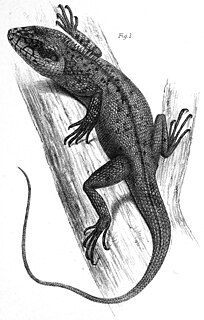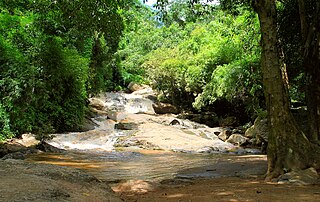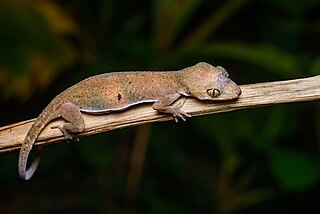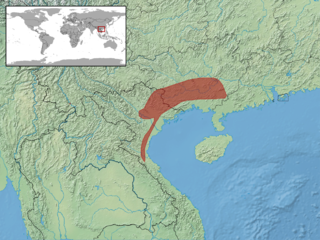
Calotes is a genus of lizards in the draconine clade of the family Agamidae. The genus contains 25 species. Some species are known as forest lizards, others as "bloodsuckers" due to their red heads, and yet others as garden lizards.

Pseudocalotes is a genus of agamid lizards endemic to Southeast Asia.

Pseudocalotes austeniana, also known commonly as the Abor Hills agama or Annandale's dragon, is a rare species of lizard in the family Agamidae. The species is endemic to Asia.

Pseudocalotes kakhienensis, the Kakhyen Hills spiny lizard, is a species of agamid lizard found in southern China, Myanmar, India, and northern Thailand. Type locality: Ponsee, Western Yunnan.
Microauris is a monotypic genus of agamid lizard. Its only species is Microauris aurantolabium, also known as the small-eared dragon or orange-lipped forest lizard, found in the forests of the southern Western Ghats and is currently known from the Kalakkad Mundanthurai Tiger Reserve. The species was formerly included in Pseudocalotes andamanensis of the Andaman Islands, but recognized as distinct in 2008. It was also classified under Calotes until 2018, where it was transferred to its own genus, Microauris, on the basis of its divergence from Calotes.
Pseudocalotes khaonanensis is the largest agamid lizard in the genus Pseudocalotes. Endemic to Thailand, it is found only in the Khao Nan mountain range in, located in the Nakhon Si Thammarat Province of Southern Thailand. Found at high elevation in Cloud/Montane Forests in the stunted tree growth associated with this habitat, in trees rich with epiphyte growth.

The Draconinae are a subfamily of reptiles in the family Agamidae found in southern Asia and Oceania. Some taxonomists believe these genera belong to the subfamily Agaminae.

Doi Suthep–Pui National Park is a national park in Chiang Mai Province in Thailand. It includes Wat Phra That Doi Suthep, a Buddhist temple, and Bhubing Palace, the winter residence of King Bhumibol Adulyadej and family. The park is a protected area for flora, fauna, and habitat.

Robert Frederick Inger was an American herpetologist.

Pseudocalotes andamanensis is an agamid lizard found on the Nicobar Islands and the Andaman Islands in India. It is also known as the green crestless forest lizard, Andaman and Nicobar forest lizard, Andaman lizard, or Andaman green calotes. This species is an almost exclusive canopy dweller, and is rarely seen.

Pseudocalotes microlepis, also known as Burmese false bloodsucker or small-scaled forest agamid, is a species of agamid lizard in the genus Pseudocalotes found in southern China, Thailand, Laos, Myanmar and Vietnam.

The skin-toe forest gecko is a species of gecko found in Phetchabun and Loei provinces of Thailand as well in Laos.

Pseudocalotes floweri, the Thai false bloodsucker or Flower’s forest agamid, is a species of agamid lizard. It is found in Thailand, Cambodia, and Vietnam.

Natalia Ananjeva is a Russian herpetologist, zoologist, and a specialist in taxonomy, phylogeny, the biogeography of Eurasian reptiles and amphibians, and the conservation of their biodiversity.

Pseudocalotes brevipes, the Vietnam false bloodsucker, is a species of agamid lizard. It is found in China and Vietnam.
Pseudocalotes kingdonwardi, Kingdonward's bloodsucker, is a species of agamid lizard. It is found in China and Myanmar.
Pseudocalotes poilani, the Laotian false bloodsucker, is a species of agamid lizard. It is found in Laos











